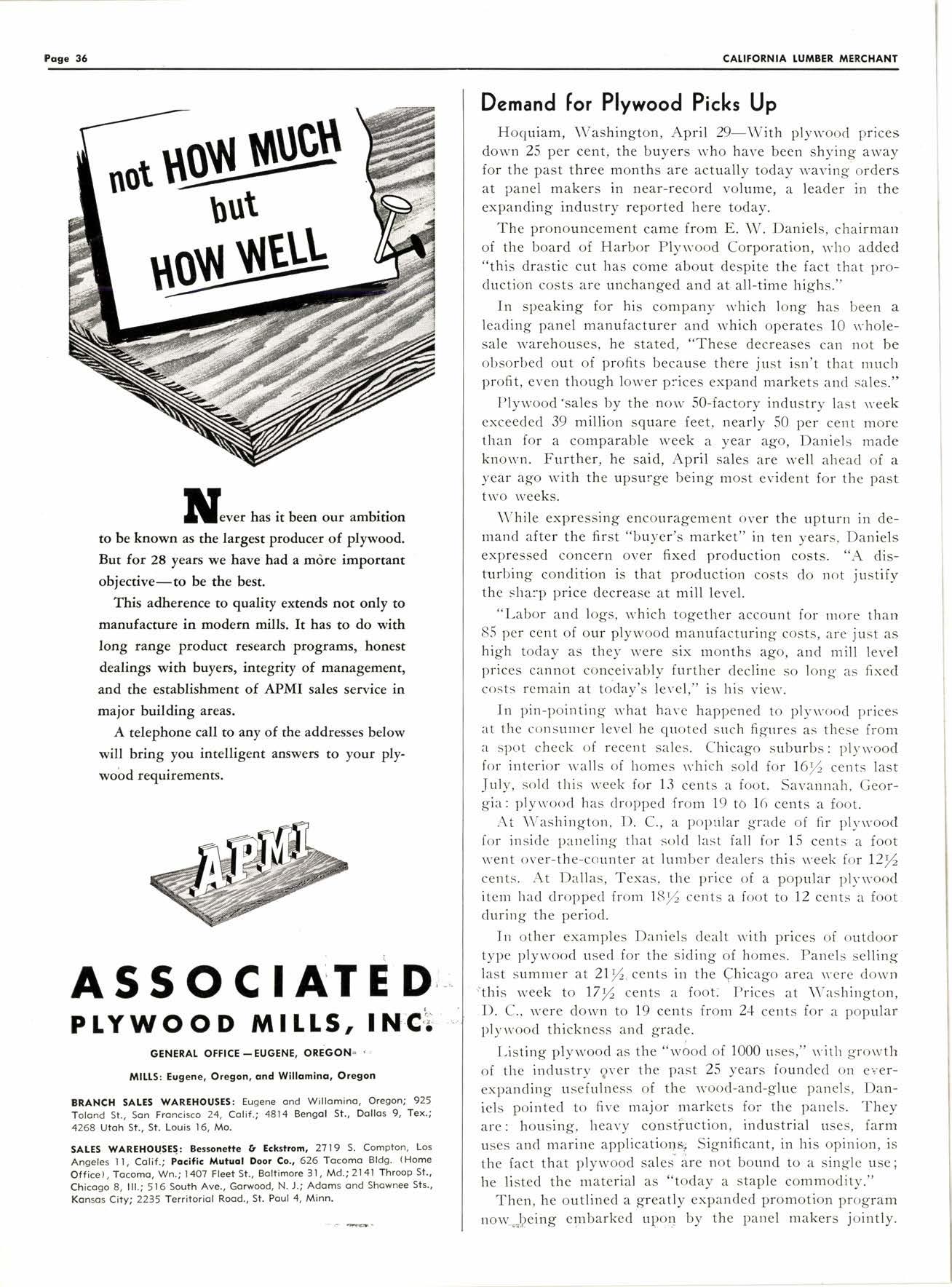
2 minute read
ASSOCIATED' PTYWOOD MItls, INC€
GENERAT OFFICE_EUGENE, OREGON- ", MILLS: Eugene, Oregon, ond Willomino, Oregon fn reviewing the growth of the industry, which had its inception at St. John's, Oregon, in 1905, the speaker stressed the leading role that Grays Harbor firms have had in the development. The Harbor Plywood Corporation plant was built at Hoquiam in 1925, and the company introduced the first waterproof type plywood nine years late. Aberdeen Plywood Corporation was established in 1928, later destroyed but promptly rebuilt, and West Coast Plywood Cornpany began operations in 1936.
BRANCH SALES WAREHOUSES: Eugene ond Willomino, Oregon; 925 Tolond St., Son Froncisco 24, Colif; 4814 Bengol St', Dollos 9, Tex.; 4268 Utoh St., St. Louis 16, Mo.
SALES WAREHOISE!: Besmnett€ & Ecksftom, 2719 S. Compton, Los Angeles I l, Colif.; Pocific Mutuol Door Co., 626 Tocomo Bldg. (Home Off ice), Tocomo, Wn.; l4O7 Fleet St., Boltimore 31, Md.; 2l4l Throop St., Chicogo 8, lll.; 5,|6 South Ave., Gorwood, N. J.; Adoms ond Shownee Sts., Konsos City; 2235 Territoriol Rood., St. Poul 4, Minn.
In other examples Daniels dealt rvith prices of outdoor type plyrvood used for the siding of homes. Panels selling last summer at 2ll, cents in the Qhicago area l'ere dorvn this r'veek to 17 I cents a foot. I'rices at \\rashington, I). C., rvere dolvn to 19 cents lrom 24 cents for a popular pll'1v66.1 thickness ar-rd grade.
I-isting plywood.as the "rvood of 1000 rlses," u'ith grorvth of the industry over the past 25 years founcled on e;erexpanding usefulness of the u'ood-and-glue panels, Daniels pointed to five major tnarkets for the panels. They are : housing, heavy constiuctiorr, industrial uses, farm uses and marine applications: Significant, in his opinion, is the Iact that plyrvood sales are not boturd to a single use ; he listed the material as "todav a staple commodity."
Then, he outlined a greatly expanded promotion pr()gram norv.J.eing en.rbarked ugoq by the panel makers jointly.
The industry adve::tising will be to generate further acceptance in all fields, particularly on the farm where plywood has been proved superior for many buildings, including grain bins, which soon will be urgently needed.
The trvin-cities continue to produce more Douglas fir plywood than any other community.
"Random Lengths"
"Random Lengths," a new book by H. J. (Herb) Cox, is full of colorful and interesting experiences and reminiscences of his 40-odd years in the lumber industry.
Mr. Cox has been actively engaged in the Western Oregon lurnber industry since 1907, for the past 21 years serving as secretary-manager of the Willamette Valley Lumbermen's Association, and for 16 years as area representative of the West Coast Luinbermen's Association. He is now associated with the Reeves Taylor Lumber Co. of Eugene.
Copies of the book can be obtained by writing H. J. Cox, P.O. Box 1192, Eugene, Ore. The price is 97.50 per single copy; $6.50 for quantities of two or more books.









